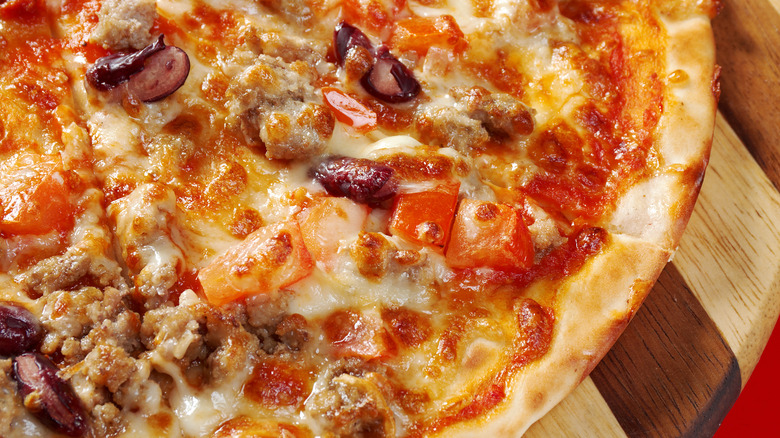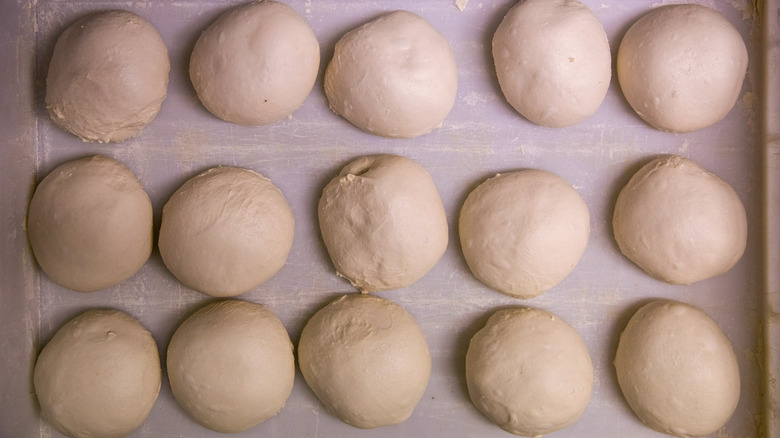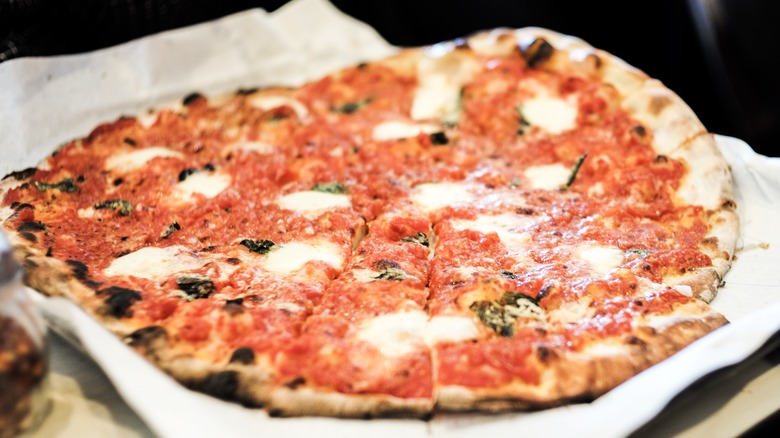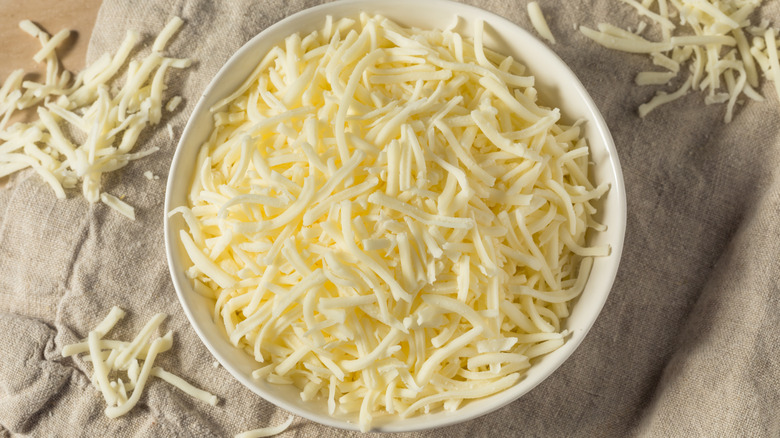What Makes New Haven-Style Pizza So Unique?
St. Louis has barbecue, the South has soul food, and Boston has an aptly named cream pie. But in New Haven, pizza is king.
And not just any pizza — we're talking about the apizza that made New Haven one of the best pizza cities in the U.S. Pronounced "ah-beetz," this pizza style was initially brought to the United States from Italian immigrants who came to the city in the early 1900s. One of those immigrants was Frank Pepe, who started slinging dough in his pizzeria on Wooster Street in 1925. His restaurant, which is still held in the family's name, inspired a slurry of other pizza restaurants to crop up and create their own version of the Naples-inspired pie.
This thin-crust, charred pie is unlike any type of pizza you've ordered from a slice shop or a pizzeria outside of New Haven. The proliferation of this pie has made New Haven a pizza destination for foodies and has entrenched itself deep in the city's culture. Here's what makes the apizza stand out.
It's made in a coal-fired oven
One of the major differences between New Haven apizza and other regional pizza styles is the oven that the pie is cooked in. Pizza ovens can be powered by many materials, often wood or gas, but the apizza style uses coal to generate the perfect char on its crust. Coal ovens can reach temperatures of over 800 degrees Fahrenheit, but many pizzaolos will cook their pies at around 600 degrees Fahrenheit, which is critical to blistering the crust of the pie without taking too much moisture out from inside of it. And since the coal ovens get so hot so quickly, apizza can cook in the oven for up to 12 minutes. In comparison, wood-fire ovens burn at 800-1,000 degrees Fahrenheit to produce a soft, collapsible crust typical of a Neapolitan-style pizza.
So why coal? It's believed that coal was first used to fire the ovens in New Haven because it was readily available. In the 1920s, when the apizza industry was just starting in New Haven, coal was cheaper than wood, so it made more sense to use this more affordable alternative. Some restaurants, including Pepe's and Sally's in New Haven, still use coal-fired cooking methods, but other pizzerias have switched over to gas or oil (like Modern).
The sauce on an apizza is more tart than other pies
If you have the opportunity to try a red pie from one of New Haven's iconic pizza joints, you'll quickly realize that the sauce makes you pucker a bit more than the average New York-style slice. This is because the red sauce used for apizza is very mild in flavor and has very little sweetness to it. The sauce is also made with San Marzano tomatoes, which are sourced from the volcanic soils of Italy. There are also some folks who have boldly claimed that the "sauce" on an apizza is just tomatoes. But it's actually made with other traditional sauce ingredients, just in different proportions.
So why is the tomato sauce on this pie so tart and so sparse? It's to highlight the other toppings and crust, of course. If you're a big fan of this style of sauce, you might as well order an original tomato pie, which is simply topped with said sauce, olive oil, and grated pecorino romano.
Apizza crust has a longer fermentation period
It's safe to say that all parts of the New Haven apizza differ from other pizza styles, including the crust. Every bite is filled with charred, sooty flavor from the coal oven, but it's also the fermentation process that makes this crust absolute magic. Apizza dough is fermented for longer than other styles, which allows the yeast to slowly eat the sugars in the dough and develop a more complex flavor. Pizzaolos start with a bromated, high-gluten flour which is mixed with water to create a dough with a hydration ratio of around 70%. If you're not clued into bread lingo yet, just know that this means that the dough is very, very wet and sticky. The potassium bromate, which cooks off in the oven, helps bind the gluten together and makes the dough easier to work with.
In addition, there might be something in the water in New Haven that gives the crust its distinct flavor. The area is said to have a slightly different mineral profile than other areas, which can alter the flavor of the dough. When these forces are combined, the result is a crisp and airy crust resembling a thin ciabatta.
The crust is charred, not burnt
The biggest mistake you can make with going to a New Haven apizza joint is asking for your crust "not-burnt." New Haven apizza is not burnt, it is charred. This means that every bite is filled with pockets of crisp crust and bits of soot, creating a magical eating experience.
Apizza is traditionally cooked in the oven so that the edges are blackened, and there are some spots of black or brown on the bottom — which people in the pizza world call "leoparding." Some people classify this as burnt, but in New Haven this is just the standard. It's difficult to control the hot spots in the oven and ensure that the pie comes out golden brown, so a couple of areas of char is just collateral damage. If this sort of color and flavor isn't making your tastebuds tingle, you might want to try a different style of pizza.
It doesn't come with mozzarella unless you ask for it
One of the biggest cultural shocks to people who have never tried New Haven apizza is the lack of mozzarella cheese on the pies. Typically, pizzerias slather on as much cheese as possible on the pie to give it a thick cheese pull. But in New Haven, mozzarella (or "mootz") is merely a topping you must specifically ask for.
The first pies in the city were not topped with mozzarella because it took away from the balance of other ingredients on the crust. If you order a famous tomato pie, for example, you'll only get a pie with tomato sauce, grated pecorino romano, and olive oil. Many of the New Haven pizzerias' white pies also do not have any mozzarella cheese; the go-to is often a little (emphasis on "little") smattering of grated cheese to balance out the other toppings.
Apizza comes in both white and red pies
Our recommendations for the best apizza order? As seasoned veterans of the New Haven apizza scene, we can confidently say that it's all up to your personal preferences. While the original tomato pie is a slice of history, so is Frank Pepe's white clam pie. This popular pie is made with fresh clams, garlic, herbs, grated pecorino romano, and olive oil. The best type of clam to use for New Haven-Style pizza is the littleneck, which was prolific around the region when the pizzerias first started to open. It's soft, juicy, and provides the perfect salty bite for this classic New Haven apizza. Some folks will also elect to add bacon to this pie ─ which might raise the eyebrows of apizza purists.
That's not to say New Haven's pizza scene isn't innovative. Bar, one of the most popular apizza spots in the city, is very well-known for its white mashed potato bacon pizza, which has become as integral to the fiber of the city as the white clam pie.






